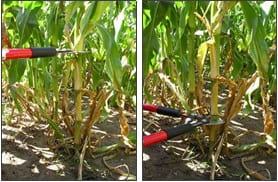by Jodi Putman
In certain respects, corn can be considered a luxury consumer of nitrogen (N), much the same as alfalfa is a luxury consumer of potassium: if the nutrient is available in the soil, it will be consumed by the crop beyond the actual requirement and to levels which do not produce a yield response. In corn, the extra N builds up in the lower parts of the stalks and you can sample this area to help guide future management decisions. The end-of-season corn stalk nitrate test (CSNT) measures nitrate concentrations in the lower portion of the corn stalks at silage or grain harvest time and can help identify where “luxury consumption” of N has occurred. This test is a useful tool, as it helps fine-tune nitrogen (N) management over time and on a field by field basis. Since it was first developed, CSNT sampling has increased across the US and New York farms.
Basic Sampling Protocols

Photo: J. Putman / CCE NWNY Team
- Collect an 8-inch portion of each stalk, between 6 and 14 inches above the ground.
- Remove leaf sheaths.
- Stalk pieces should be handled to avoid contact with soil.
- AVOID sampling corn with significant damage from disease or insects.
- We recommend CSNT sampling 2nd-year corn or higher.
Post-harvest Sampling Protocols
- Adhering to a standardized sampling protocol in the field is very important!
- If silage cutting height exceeds 14 inches, we suggest following the protocol above.
- When stubble is less than 14 inches but greater than 8 inches, stalk samples can be taken between 2 and 8 inches off the ground. **This alternative cutting height needs to be reported to the laboratory when submitting CSNT samples, so the laboratory staff can properly adjust sample results.
- Collecting samples in the field up to 5 days after harvest will not affect CSNT results (assuming no significant rainfall, soil disturbance, or manure applications in that time period).
- Samples can be stored in the fridge for up to 8 days if direct mailing is not feasible; avoid freezing.
Crop management records should be used to evaluate CSNT results and determine where changes can be made. Adapted from: http://nmsp.cals.cornell.edu/publications/factsheets/factsheet72.pdf.

